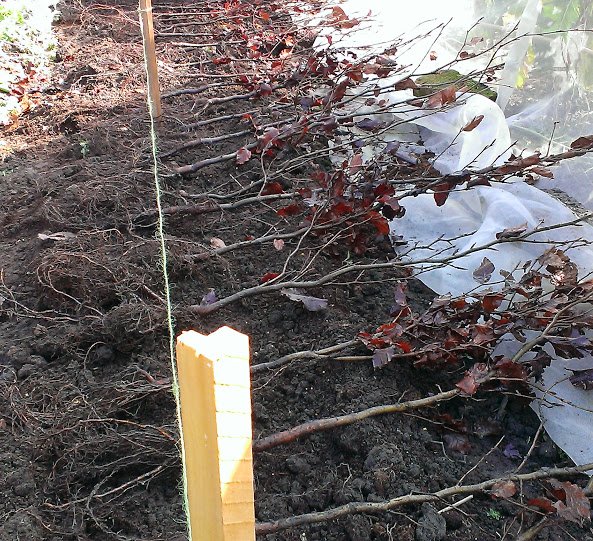Bare-root Tree and Hedging - What and When to Plant
When the trees start to lose thier leaves at this time of year it's a sure sign that the dormant season is upon us. It’s the perfect time to transplant bare-root plants – those which have been raised in a field and then lifted & the soil removed. The added bonus of bare-root plants is that they are much cheaper than container grown plants.
Autumn is a good time to plant them as there’s time for them to settle and establish before the warmth of the spring comes. Trees & shrubs are available bare-root and from November onwards they’ll be offered in garden centres, nurseries and online. As the plants are dormant there’s not much to look at but when selecting plants look for undamaged branches & bark to ensure the plants are fit and healthy.
My garden has tall boundary hedges of Privet and the garden it’s self is sub-divided by Beech hedges and trained fruit trees, all of which were sourced as bare-root plants. Fruit trees are the typical bare-root trees on offer in garden centres. Apples, Plums and Pears are easy to find. Choose a variety based on the crop, size, shape and pollination requirements (info will be on the label).
Ornamental trees like Rowans, Hawthorns and Acers are popular too, choose a variety that will grow to a suitable size and give interest in flowers, foliage or berries.
My garden has tall boundary hedges of Privet and the garden it’s self is sub-divided by Beech hedges and trained fruit trees, all of which were sourced as bare-root plants. Fruit trees are the typical bare-root trees on offer in garden centres. Apples, Plums and Pears are easy to find. Choose a variety based on the crop, size, shape and pollination requirements (info will be on the label).
Ornamental trees like Rowans, Hawthorns and Acers are popular too, choose a variety that will grow to a suitable size and give interest in flowers, foliage or berries.
Bundles of hedging plants known as ‘Whips’, are available from November to March. Hedges are great for defining a boundary, screening a building or dividing a garden into sections. There are lots of varieties to choose from. For formal edging there are evergreens like Box and Yew and for taller boundary hedges, semi-evergreens like Privet or Beech are suitable. Trimmed twice a year these can be kept neat & tidy.
Native hedging typically consists of a mix of deciduous varieties which when planted together provides an ideal habitat for wildlife. A traditional mix includes Haw & Black Thorn, Hazel, Dogwood and Wild Rose & Crab Apple. Deciduous mixes are less formal and can be trimmed once a year or less frequently for an informal look.
Find a good nursery or garden centre and they should be able to supply you with bundles of whips / bare-root trees now or alternatively by online from a reputable supplier - just be sure you are buying quality plants.


